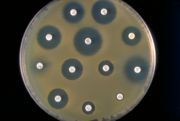
Bacterial lawn
Encyclopedia

Microbiologist
A microbiologist is a scientist who works in the field of microbiology. Microbiologists study organisms called microbes. Microbes can take the form of bacteria, viruses, fungi, and protists...
s to describe the appearance of bacteria
Bacteria
Bacteria are a large domain of prokaryotic microorganisms. Typically a few micrometres in length, bacteria have a wide range of shapes, ranging from spheres to rods and spirals...
l colonies
Colony (biology)
In biology, a colony reference to several individual organisms of the same species living closely together, usually for mutual benefit, such as stronger defense or the ability to attack bigger prey. Some insects live only in colonies...
when all the individual colonies on a petri-dish agar plate
Agar plate
An agar plate is a Petri dish that contains a growth medium used to culture microorganisms or small plants like the moss Physcomitrella patens.Selective growth compounds may also be added to the media, such as antibiotics....
merge together to form a field or mat of bacteria. Bacterial lawns find use in screens for antibiotic resistance
Antibiotic resistance
Antibiotic resistance is a type of drug resistance where a microorganism is able to survive exposure to an antibiotic. While a spontaneous or induced genetic mutation in bacteria may confer resistance to antimicrobial drugs, genes that confer resistance can be transferred between bacteria in a...
and bacteriophage
Bacteriophage
A bacteriophage is any one of a number of viruses that infect bacteria. They do this by injecting genetic material, which they carry enclosed in an outer protein capsid...
titering.
Bacterial lawns (often of Serratia marcescens
Serratia marcescens
Serratia marcescens is a species of Gram-negative, rod-shaped bacterium in the family Enterobacteriaceae. A human pathogen, S. marcescens is involved in nosocomial infections, particularly catheter-associated bacteremia, urinary tract infections and wound infections, and is responsible for 1.4% of...
) are also used extensively when as an assay method when using bacteriophage
Bacteriophage
A bacteriophage is any one of a number of viruses that infect bacteria. They do this by injecting genetic material, which they carry enclosed in an outer protein capsid...
as tracers in studies of groundwater flow.
Although occasionally used as a synonym for biofilm
Biofilm
A biofilm is an aggregate of microorganisms in which cells adhere to each other on a surface. These adherent cells are frequently embedded within a self-produced matrix of extracellular polymeric substance...
, the term primarily applies to the simple, clonal, unstructured mats of organisms that typically only form on laboratory growth media. Biofilms—the aggregated form of microorganism
Microorganism
A microorganism or microbe is a microscopic organism that comprises either a single cell , cell clusters, or no cell at all...
s most commonly found in nature
Nature
Nature, in the broadest sense, is equivalent to the natural world, physical world, or material world. "Nature" refers to the phenomena of the physical world, and also to life in general...
— are generally more complex and diverse and marked by larger quantities of extracellular structural matrix relative to the cellular biomass
Biomass (ecology)
Biomass, in ecology, is the mass of living biological organisms in a given area or ecosystem at a given time. Biomass can refer to species biomass, which is the mass of one or more species, or to community biomass, which is the mass of all species in the community. It can include microorganisms,...
.

